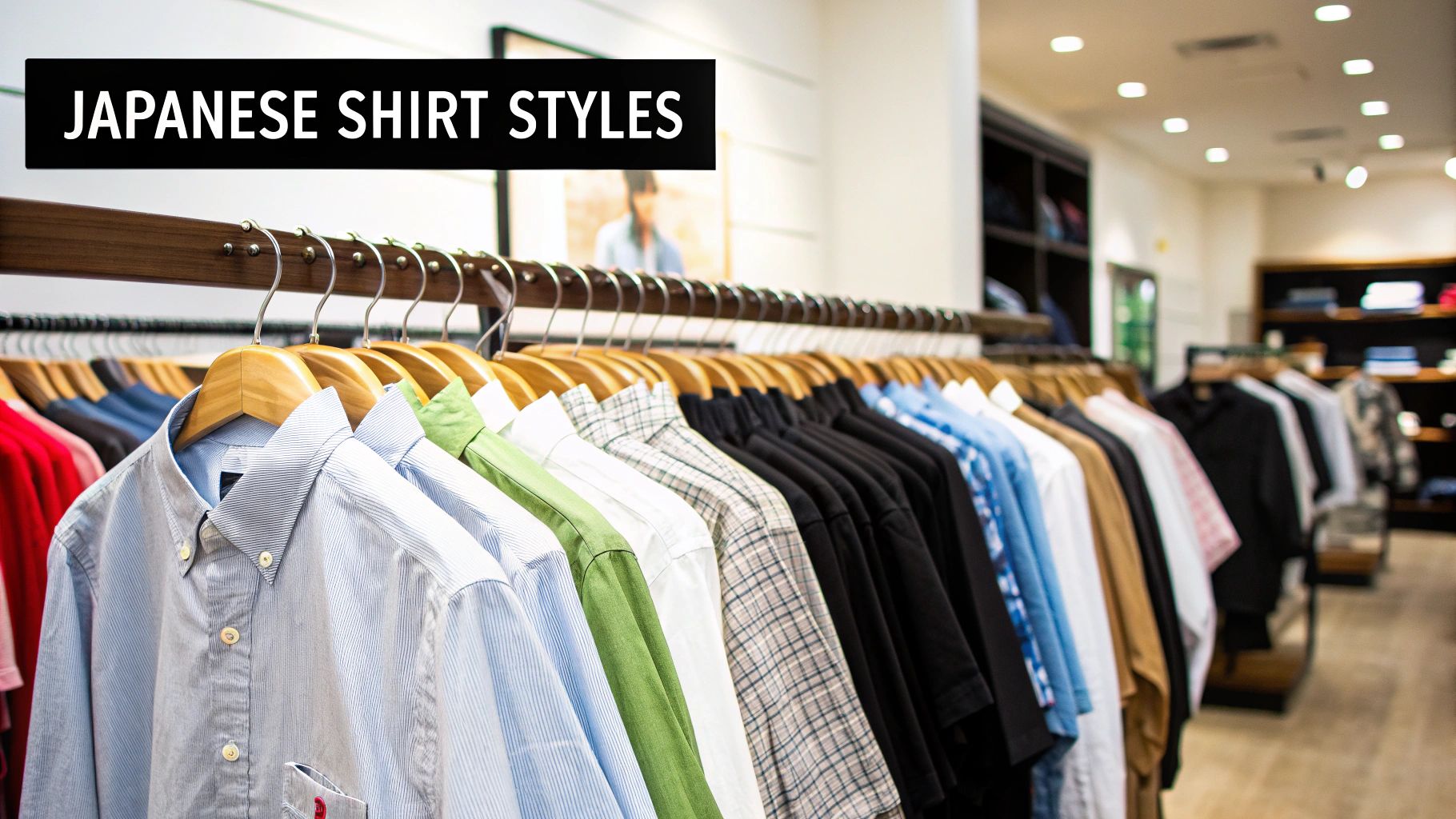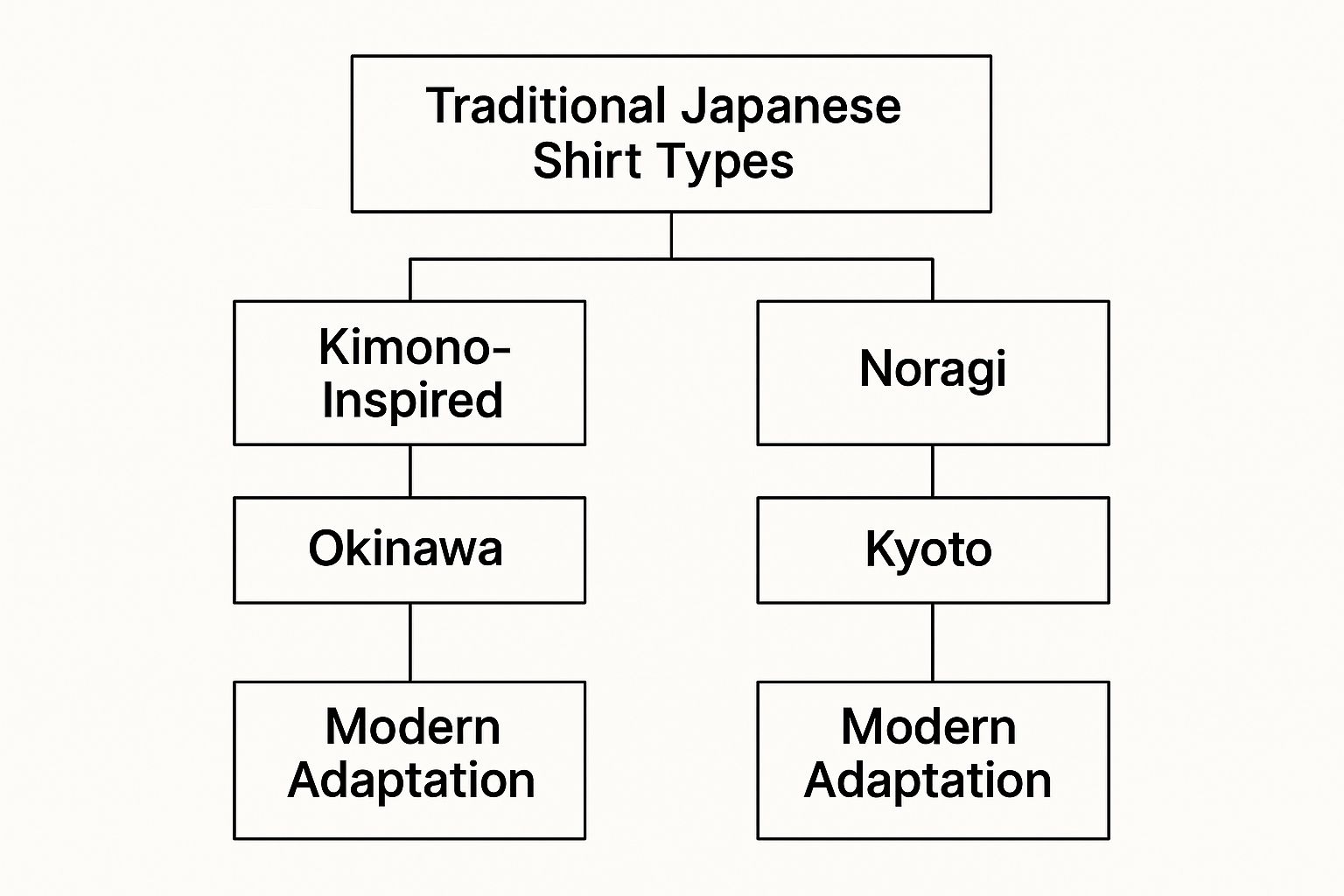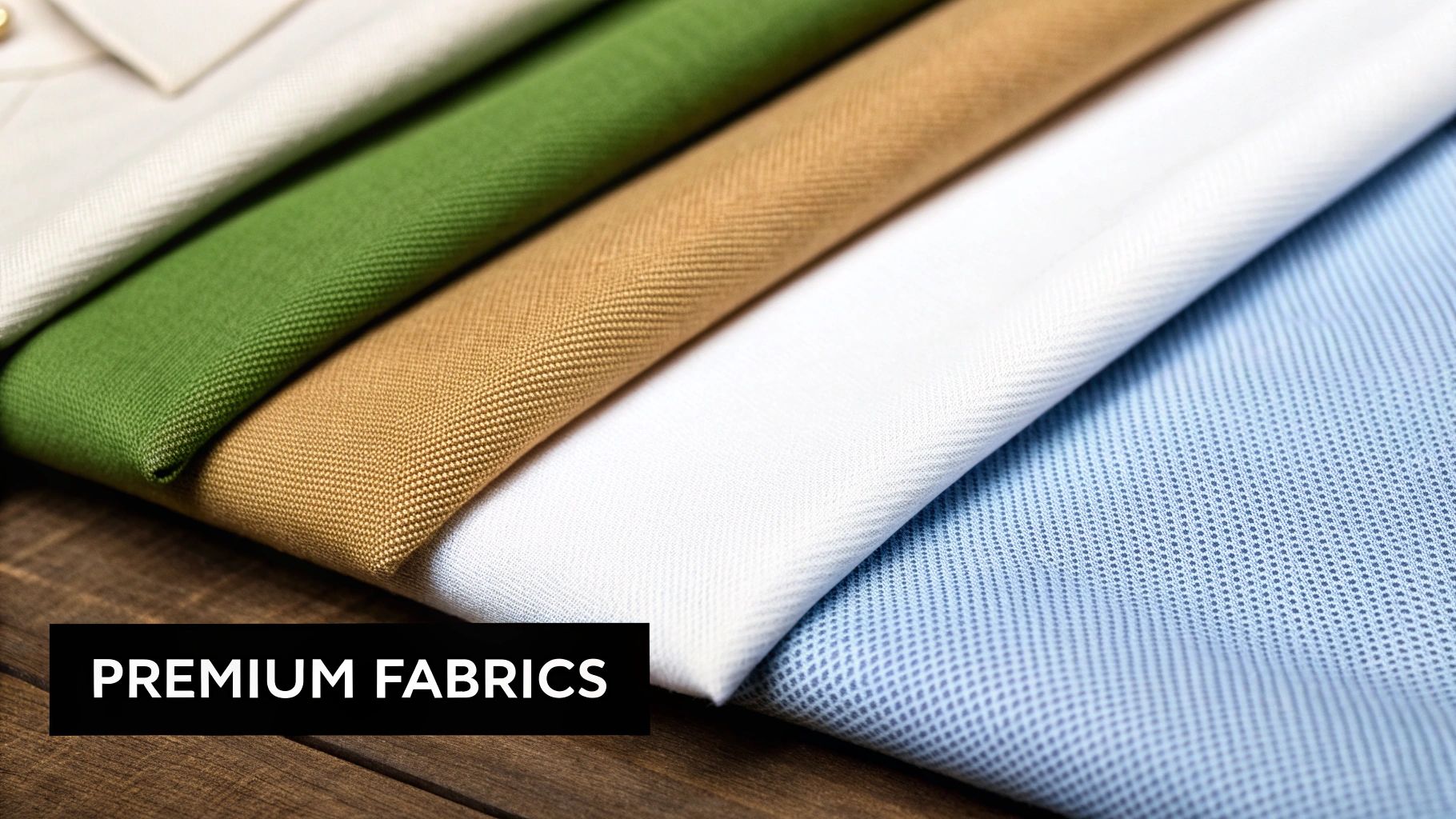
Shirt Japan: The Ultimate Guide to Japanese Shirt Styles
Share
A Japanese shirt is more than just clothing—it's wearable art. Each piece tells a story, weaving intricate designs and traditional symbols into something you can actually own and wear.
These aren't just prints on fabric. They're a fusion of centuries of artistic heritage and modern fashion, making them a seriously unique addition to any wardrobe.
Your Guide to Japanese Shirt Culture

Welcome to the world of Japanese shirts, where every thread tells a tale of culture, history, and incredible craftsmanship. Forget your standard high-street button-down; these garments are canvases for storytelling, steeped in a rich history that makes each one both visually stunning and deeply meaningful.
This guide is your introduction to the unique aesthetic that makes a shirt from Japan so sought after.
This isn't some new trend, either. Japan has a long legacy as a powerhouse in textile production. Back in the interwar years, the country was exporting huge quantities of materials like "grey shirtings"—a foundational cotton cloth. You can actually dig into the data on this academic archive to see how deep these roots go. That expertise laid the groundwork for the incredible quality we see today.
So, let's get into it. We'll cover everything you need to know, from iconic art styles to how to actually wear these pieces without looking like a tourist.
- Iconic Motifs: We'll decode the symbolism behind the dragons, koi, and cherry blossoms you see everywhere.
- Key Styles: You'll learn the difference between a bold Sukajan jacket and an elegant Ukiyo-e print.
- Fabric Choices: We'll break down how materials like cotton, rayon, and silk completely change the look and feel.
By the end of this, you’ll understand why owning a Japanese shirt isn't just a style choice—it's an investment in artistry and a connection to a profound cultural heritage.
Getting to Grips with Iconic Japanese Designs
A Japanese-style shirt isn't just a piece of clothing; it's a story told in ink and thread. Each design is packed with symbolism, and once you know what to look for, you’re not just picking a cool graphic—you’re choosing a statement that actually means something. These motifs aren’t random. They’re tales of power, nature, and philosophy.
Take the dragon, or ryū. In the West, we think of fire-breathing monsters. In Japan? The dragon is a wise, powerful guardian of the heavens. A dragon on your shirt is all about strength, wisdom, and a dose of good fortune, often shown swirling through clouds or water. Then you have the koi carp, famous for swimming upstream. That’s pure perseverance—a symbol of courage against all odds.
Nature, Legends, and Timeless Art
Symbolism runs deep in Japanese culture, especially when it comes to nature. The cherry blossom, or sakura, is probably the most famous example. Its stunning beauty lasts only for a short time, representing the beautiful, fragile nature of life itself. It’s a concept called mono no aware.
And you can't talk about Japanese art without mentioning "The Great Wave off Kanagawa." Hokusai's legendary ukiyo-e print is more than just a pretty picture; it captures the raw power of nature and reminds us how small we really are. Wearing it connects you to a masterpiece of Japanese art history.
Picking a design becomes personal when you get the story behind it. A tiger could be for your own fighting spirit, while a koi might represent a struggle you've beaten. It adds a whole other layer to your style.
To give you a better idea of what these popular designs mean, here's a quick rundown of some common motifs you'll find on Japanese shirts.
Common Japanese Shirt Motifs and Their Meanings
| Motif | Primary Symbolism | Common Associated Elements |
|---|---|---|
| Dragon (Ryū) | Strength, wisdom, good fortune | Clouds, water, pearls |
| Koi Carp | Perseverance, courage, success | Waterfalls, waves, lotus flowers |
| Tiger (Tora) | Strength, courage, protection | Bamboo, wind, rocks |
| Phoenix (Hō-ō) | Rebirth, good fortune, immortality | Fire, paulownia trees |
| Cherry Blossom (Sakura) | Transience of life, beauty | Wind, moon, mountains |
These symbols have been around for centuries, yet they still feel as powerful as ever.

You can see how classic pieces like the Noragi jacket have influenced modern streetwear across the globe. These motifs are so timeless they slot perfectly into today’s fashion, which is exactly why so many brands work with custom t-shirt printers to get these ancient designs onto fresh threads.
Every print carries hundreds of years of cultural history, turning your shirt into a piece of wearable art.
Japanese Shirt Styles: A Tale of Two Threads

When you’re picking a Japanese-themed shirt, you’re not just choosing a design. You’re choosing a side.
On one hand, you’ve got the Sukajan (souvenir jacket) style—loud, proud, and covered in dense, vibrant embroidery. It’s rebellion stitched into fabric.
On the other, you have shirts inspired by Ukiyo-e prints. These are more subtle, channelling the elegant, flowing lines of traditional woodblock art. It’s wearable poetry.
Think of it this way: the Sukajan style is a tapestry you wear. The designs are literally built on top of the fabric, giving it texture, weight, and an in-your-face attitude. Ukiyo-e prints, however, feel like part of the shirt itself. The art is smooth, seamless, and speaks with a quieter confidence.
So, what’s it going to be? The textured, rebellious roar of embroidery, or the cool, artistic grace of a classic print? Your call.
Feel The Difference: Fabric Is Everything
The material of your shirt is just as crucial as the artwork. It dictates the comfort, the look, and where you can actually wear the thing without looking out of place.
-
Rayon: Silky, smooth, and lets colours pop like nothing else. This is the go-to for high-end Japanese shirts, especially those with detailed prints. It hangs beautifully and is light enough for when things heat up.
-
Cotton: The undisputed champ of everyday wear. It’s breathable, comfortable, and a solid canvas for both prints and lighter embroidery. Easy to care for, easy to wear.
-
Silk: Pure, unapologetic luxury. Nothing else has that same shimmer and softness. It’s a high-maintenance fabric, for sure, but the feel is second to none.
Understanding how the design gets onto the fabric is part of the game, too. Knowing the difference between DTF printing and screen printing gives you a deeper appreciation for the craft. It lets you choose a shirt based not just on how it looks, but on how it’s built to last.
How to Rock Your Japanese Shirt Without Looking Like a Tourist
A killer Japanese shirt is a statement. A big one. The trick is to let it be the hero of your outfit, not the whole damn show. Think of it like a lead guitarist shredding a solo—the rest of the band needs to hold down the rhythm, not try to play their own solo at the same time.
For a casual, everyday vibe, the rule is simple: keep everything else quiet. That vibrant, intricate shirt you just bought? It’ll look incredible with dark-wash denim, black jeans, or a pair of simple beige chinos. The contrast gives the shirt’s artwork the clean stage it deserves.
Building Your Look
You need to create that balance by sticking to solid, understated colours for your trousers and shoes. Let the shirt do the shouting.
- Trousers: Go for black, navy, charcoal, or khaki. Anything with a pattern or a bright colour is just going to start a fight with your shirt's design.
- Footwear: Clean, minimal trainers in white or black are always a win. If you want to smarten it up a bit, think simple leather boots or loafers.
- Outerwear: If you need another layer, a plain black or navy bomber jacket is perfect. A simple denim jacket works too. They frame the shirt without covering up the good bits.
Want a sharper look? Throw your shirt under an unstructured blazer. A dark navy or grey one lets just enough of the pattern show, adding a flash of personality to a smart-casual outfit without going over the top.
Look, the most important thing is to wear it like you mean it. A Japanese shirt is a bold move. Own it. That's what really makes the outfit work.
At the end of the day, styling a shirt japan is about finding harmony. Pair its complex beauty with simple, classic pieces, and you'll stand out for all the right reasons. Effortlessly cool, not embarrassingly loud.
Where to Find Authentic Japanese Shirts

Finding a proper Japanese shirt is about knowing where to look and what to look for. It’s a hunt, but it’s a rewarding one that connects you with real artisans and brands that actually care about quality.
Your best bet? Start with specialised online retailers. Plenty of UK-based stores now pull together killer collections, mixing traditional Japanese art with modern streetwear vibes. Diving into a dedicated collection of Japanese t-shirts in the UK is the easiest way to find top-notch prints without getting tangled in international shipping yourself. They’ve already done the hard graft for you.
Thanks to a strong trade relationship, getting this stuff from Japan to the UK is easier than ever. We're talking a £31.0 billion exchange, and clothing is a big slice of that pie. You'll find a lot of it landing in London and the East Midlands, which just goes to show how much demand there is for proper Japanese gear.
Vetting Your Purchase for Authenticity
Whether you’re scrolling online or digging through racks in a boutique, a few details will always separate the real deal from a cheap knock-off. Keep your eyes peeled for these things, and you’ll end up with a piece that lasts.
- Embroidery Quality: Look for dense, tight stitching. No loose threads. Authentic Sukajan embroidery has a real texture and weight to it—it’s not flat or patchy.
- Print Clarity: Ukiyo-e prints and other graphics should be razor-sharp. If you see blurry lines or washed-out colours, it's a dead giveaway of a poor-quality transfer.
- Fabric Feel: Real Japanese shirts often use rayon for that silky, drapey feel or high-quality cotton that actually breathes. If it feels flimsy or rough, it’s a knock-off.
An authentic Japanese shirt feels like a piece of art you can wear. The weight of the fabric, the precision in the stitching, the richness of the colours—it all just feels right.
At the end of the day, buying a genuine shirt from Japan is an investment. Stick to specialist sellers, check the quality yourself, and you’ll walk away with something that honours its roots and adds some serious character to your wardrobe.
Got Questions About Japanese Shirts? We've Got Answers
So, you've found a design you love, but you've got a few questions before you commit. It's totally normal. Diving into the world of Japanese apparel means navigating different sizing, fabrics, and cultural nuances. Let's clear up the common sticking points so you can wear your new piece with confidence.
Sizing is probably the biggest hurdle. Let's be blunt: Japanese sizes often run smaller than what you're used to in the UK. A 'Large' from a Tokyo brand might fit more like a UK 'Medium'. Don't guess. Always, always check the brand’s measurement chart. Pay special attention to the chest and shoulder width – that's where you'll get the truest fit.
Look After Your Wearable Art
You wouldn't leave a painting out in the rain, right? Think of your shirt the same way. The vibrant colours and often delicate fabrics in a shirt japan need a bit of respect to stay looking sharp. Many are made from rayon or silk, which demand a gentle touch.
- Hand Wash Is King: For anything rayon or silk, your best bet is hand washing in cold water with a mild detergent. It's the safest way to prevent fading or damage.
- The Dryer Is Your Enemy: Seriously, just don't. The intense heat from a tumble dryer can shrink the fabric and absolutely destroy the print or embroidery.
- Air Dry The Right Way: Lay it flat on a clean towel or pop it on a padded hanger, but keep it out of direct sunlight.
Got a cotton one? You're usually safe with a cool, gentle machine wash. Just remember to turn it inside out first to protect that killer design.
It's not just a shirt; it's a piece of art. Treat it like one, and it'll look incredible for years. Harsh chemicals and extreme heat are for other things. Not this.
Wearing It Right: Culture and Sizing
A big question we hear is, "Is it okay for me, a non-Japanese person, to wear this?" The answer is a resounding yes. Japanese culture has a rich history of sharing its art with the world, and these shirts are just the latest chapter. Wearing one is seen for what it is: a sign of appreciation for the craftsmanship and culture.
The UK's love for high-quality Japanese goods is undeniable. Japan's exports to the UK clock in at around US$11.24 billion. While cars make up a big chunk of that, textiles and apparel are right in there, too. This isn't just a niche interest; there's real demand for the artistry your shirt represents. You can get a deeper look into Japanese trade with the UK on this economic data site.
Just wear it with respect. You're not just wearing a shirt; you're celebrating a piece of global art.
Ready to find a Japanese shirt that actually says something? At Psyque, we specialise in high-quality, DTF-printed apparel with Japanese-inspired designs that hit hard. https://psyque.co.uk
more articles:
Your Essential Guide to Japan Tees and Streetwear
Finding Custom Printed Shirts Near Me
7 Best Places for Christian Apparel UK in 2025
